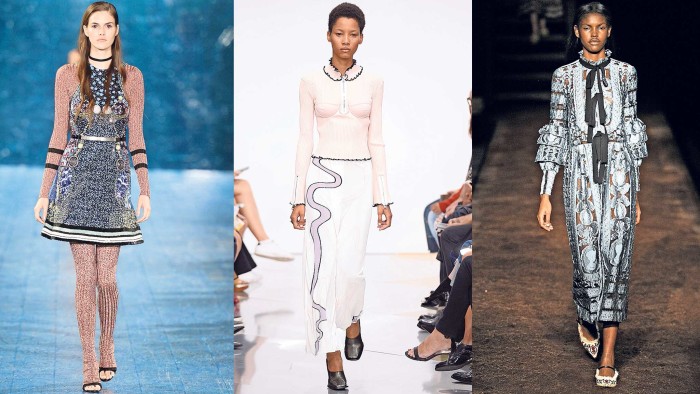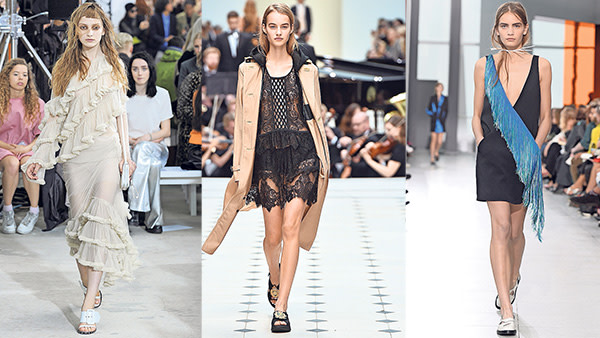London Fashion Week round-up

Roula Khalaf, Editor of the FT, selects her favourite stories in this weekly newsletter.
On the surface, this has been a great year for British fashion. Christopher Kane, Erdem, Simone Rocha and, at last, Hussein Chalayan, have opened bright, shiny stores in the capital. British label Marques’Almeida scored the €300,000 bonus that came with the LVMH Young Fashion Designer prize , a shot in the arm for a nascent brand, while Jonathan Saunders secured investment for his 11-year-old label that should ensure growth and productivity: his backer, the 32-year-old Indian businesswoman Eiesha Bharti Pasricha, who also invested in Roksanda last year, has emerged as a fashion fairy-godmother in the UK.
Why then, with so many outward signs of success, does this appear to have been such a challenging year for so many British labels? Speaking to buyers and merchandisers between the shows at London Fashion Week, many winced when I asked about sales. “It has been tough,” was a common response.
It’s certainly not for want of talent. The collections were as bold and beautiful a bombardment of ideas as you’ll see in any city this season. Collections that grabbed the eye and held the attention from first look to last. Neither is it a problem of infrastructure: the influence of NewGen, the initiative established by the British Fashion Council in 1993 to offer business guidance and introductions to graduate designers, has helped transform how labels get to market — and survive.
Analyst Luca Solca, head of luxury goods at Exane BNP Paribas, offers a diagnosis: “The stronger pound is a factor. But the most important challenge for newer brands is finding a balance between commercial appeal and innovation. It’s easier if you’re very small; not so easy as you get bigger.”
In other words, success can bedevil a label. The bigger it gets (and many London brands have celebrated their 10th birthdays this year), the more stock it needs and the bolder, more on-brand and more broadly priced the merchandise must be. “It demands you take a more ‘commercial’ and structured approach to the market, which can cause teething problems,” says Solca.
Not all British brands are small — after all, Kering bought a majority share in Christopher Kane in 2013 that has catapulted the brand into a new league of luxury alongside more established labels such as Stella McCartney and Alexander McQueen (also part of the group). But their comparative youth means that, as yet, they have no heritage to lean on. An established brand such as Burberry can show a SS16 collection of simple black military tailoring, macramé lace and cream slip dresses because it knows people will buy its scarves. Novelty is less of an issue (although the Burberry show was novel for its calm sophistication, and a thrilling live performance by Alison Moyet).
British designers are celebrated for their unique point of view: the very essence of London Fashion Week is its sense of edgy experimentation, its eccentricity and wit. But this has created a strange paradox: sales here are currently focused at the very top end of the market. Buyers sweep up show standouts — such as the cosmology-inspired dresses that opened Mary Katrantzou (the designer’s dresses retail for £6,000-£10,000 and sell out as soon as they hit the sales floor) — but they steer away from the pieces priced around £2,500, and totally ignore the basics that are the bedrock sales for so many other brands.

Justin O’Shea, buying director for online fashion site MyTheresa, said it best when he told me: “Put on a Saint Laurent shirt and you’re wearing Saint Laurent. The brand is so well established, so confident of its creative legacy, that you can still wear a basic piece and be a part of it. For a younger, less established label, you need to wear the brand. You need the show piece.”
He then anatomised a fringed dress as seen at Christopher Kane. Its brilliance, he said, was that this one piece told the story of the whole show. It also introduced a new idea — fringing — that Kane has never worked with before. With this dress, buyers were offered novelty, but also brand signatures such as the slant pockets, razor-sharp cut and roomy silhouette. More important, the dress also unlocked the collection’s commercial potential: Kane’s fringing could now be replicated on sweatshirts or skirts, be sold at a mid-range price and still be on point with the season’s vision.
But if the financial reality is depressing, let’s rejoice instead in the brilliantly bonkers or straightforwardly lovely things we saw in London and loved: cable-tie bracelets (Kane again); jelly wire macramé vests (Simone Rocha); huge, voluminous, leg-o-mutton sleeves scribbled with Keith Haring-style squiggles and space-age ribby knits (JW Anderson, who also delivered my favourite look of the week, a wonderfully chic black suit with statement cuffs); Prairie Madness made exquisite via lacy Victorian tiered dresses (Erdem); punk ruffles and shredded chiffon at Marques’Almeida; and the perfect colour palette at Paul Smith.
And for those of you in search of an instant style update, I offer you this: go buy a length of black grosgrain and tie it in a bow about your person. OMG darling, you’re sooooo spring/summer 16.
For more reports from the London shows, go to our fashion weeks page on the FT web app
Photographs: Catwalking.com
Comments